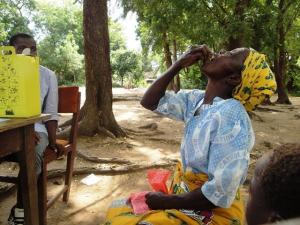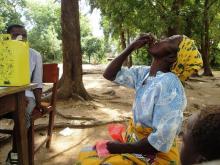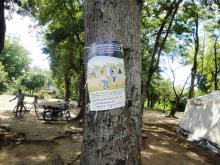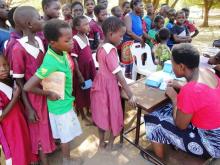84% of flood victims living in camps and people from surrounding villages immunized against Cholera in Nsanje - Malawi
Lilongwe, Malawi: 11 May 2015: The preliminary analysis reports from Nsanje District Health Office, in Malawi have shown that close to 135, 000 Internally Displaced Persons and the people from surrounding communities have so far received the Oral Cholera Vaccines (OCV) in Nsanje district. This in general represents 84% of the target population (134,603/160,482) that received the OCV.
The results also show that over two thirds of the target population (67%) received the recommended two doses and are therefore fully immunized while 16% (26,394/160,482) received only one dose. In the first round which was conducted from 30 March to 30 April achieved a coverage rate of 98% and therefore this second round has a dropout rate of 14%. There is need to critically review the issues that have resulted to this drop in turn out to the vaccination sites particularly among the cohort that was to receive the second dose of the OCV from 20 to 25 April 2015.
The campaign targeted 160,000 people that are living in camps and the surrounding villages as an additional measure to prevent and control the spread of cholera which started on 11 February 2015. The vaccine was administered to all persons over one year. The team overseeing the implementation of the OCV campaign comprised the Nsanje District Health Management Team, John Snow International Institute, the International Vaccine Institute and the World Health Organization staff from the country office as well as from the headquarters in Geneva. According to the team, the reason for the drop could be that most people were leaving their homes early morning to cultivate their crop fields that were destroyed by the floods in January 2015. The other reason could be that the key message delivered to communities through village criers, posters, leaflets and the national radio that people will need to receive the second dose of OCV in order to be fully immunized did not hit home as expected by the OCV campaign team in Nsanje.
Informal reports from the field state that some people were complaining about the taste of the vaccine and refused the second dose. Some health sites were offering sweets or water to the clients after taking the vaccine to address the problem of unpleasant taste. A coverage survey will be conducted at the end of the campaign to document successes and challenges including reasons for partial or no vaccination uptake.
World Health Organization led the design and planning process and also participated in the implementation of the Oral Cholera Vaccine in Malawi in collaboration with the International Vaccine Institute. Specifically, the International Coordinating Group (ICG) emergency stockpile provided vaccines for 105,000 people while the International Vaccine Institute provided vaccines for 55,000 people. In addition, the support from the EU Humanitarian Aid and Civil Protection department (ECHO) enabled the campaign to take place. Currently there are three WHO staff leading the implementation of the coverage survey for the Oral Cholera Vaccine. The World Health Organization is also continuing to lead the monitoring, evaluation and documentation of the best practices in the introduction of the Oral Cholera Vaccine.
____________________________________________________
For more information, please contact:
Wenji Hudson Kubwalo, Health Promotion Officer
Tel.: +2651772755/450 | +265888878011
Email: wenjikubwalo [at] gmail.com (wenjikubwalo[at]gmail[dot]com)
____________________________________________________
Below:
01. A woman taking a swig of the Oral Cholera Vaccine in Nsanje
02. In addition to face to face and radio channels, posters were also used to direct people to the sites where they would receive the dose of the Oral Cholera Vaccine in Nsanje
03. School children also received the Oral Cholera Vaccine in Nsanje



